

|
Chapter 7 War is Hell on the Home FrontT.G. Sheppard During the attack on Corpus
Christi, the Confederate forces had been under command of Colonel Hobby
with the infantry commanded by Captain John Ireland (later promoted to
Colonel), the artillery headed by Captain Neal, and the cavalry led by Captain James Ware. “Although Kittredge had failed to capture
the port, his threat to Corpus Christi was not over. He continued
to blockage the regions coastline and captured a ship, the Water Witch,
on August 23. In mid-September, the middle-aged former merchant
marine officer went too far. He raided the southwest corner of
Corpus Christi Bay and took several hostages at a community there
called Flour Bluff. The Texans had finally had enough of his
escapades. They set a trap for him. When Kittredge and his
landing party came ashore again the next day, they were soon surrounded
by Capt.
Ware’s cavalry who captured
them without firing a shot.” (Ref. 2151)
According to local resident Mary
Sutherland’s account, “The enemy
occasionally picked up a stray Johnny and carried him off to prison,
and once the Johnnies retaliated by capturing one Captain Kitteridge
who made himself obnoxious by his too frequent visits. Later he fell
into durance vile, while foraging for eggs and butter at Flour
Bluff. I do not know anything more than his capture by one Captain Ware . . . He captured
Kitteridge and did scout duty in vicinity during the entire War.”
(Ref. 3174)
In late August, James had already
garnered some high praise for his actions in the battle from Brig.
General Hamilton Bee who wrote the following letter to Headquarters:

General Hamilton Bee Letter written by Brig.
General Hamilton Bee to Headquarters on August 26, 1862
87
Bold lettering done by Judy C. Ware for benefit of family research Headquarters Sub-Mil. Dis. Of the Rio Grande Corpus Christi, Texas August 26, 1862 “Sir: I have the honor to enclose the official reports of Major A. M. Hobby, commanding this post, of the bombardment of Corpus Christi. It is with great satisfaction that I call the attention of the general commanding the Department of Texas to the judgment and gallantry of Major Hobby, as well as to the satisfactory manner in which he discharged his duty under the trying circumstances in which he was placed. The enemy brought into action seven pieces of heavy artillery, adapted to and using all the modern improvements in projectiles. Our force was two 18-pounder and one 12-pounder guns, manned by inexperienced artillerists, and supported by volunteers but a few days in the service; yet the furious fire of shot and shell by the enemy, after the first few rounds, served but to inspire the men, and their spirit and bravery are worthy of all praise. After
several hours of incessant fire on our little battery, without effect,
a force of about 40 men, with a rifled gun, was landed on the beach
about a mile from the battery (which, having but a water front, was not
able to resist their approach), and slowly advancing, endeavoring to
flank it, the three heavy gunboats being within 400 yards of the shore,
covering their advance with a continuous fire of grape and
canister. So completely did the guns of the boats cover their
approach that the advancing force may fairly be considered as equal to
two batteries of 24 and 32 pounders. To charge through such a
formidable fire seemed hopeless; yet, when almost within musket-range
of the battery, Major Hobby led a charge of 25 men and put the marines
to fight. At this moment Captain
Ware’s fine company of cavalry came dashing into the plain, and but for
the peremptory order from Major Hobby in person, would in another
moment have cut them to pieces and captured their gun; but when it is considered that this
charge would have been made through a flank fire of heavy guns, loaded
with grape and canister, at 400 yards distance, and must have resulted
in the sacrifice of most of the men, I approve of the order of Major
Hobby in restraining them, considering the object to be gained as not
88 commensurate
with the almost certain loss. It
is due to Captain Ware and his command to say that, with all its
probable consequences, they were not only ready for the work and
actually under fire, but were bitterly disappointed at losing the
opportunity thus presented. Foiled in all his plans, the enemy
vented his spleen on the defenseless houses of the town for a short
time and then withdrew, with his fleet badly crippled, but with what
loss we have no means of knowing. Between 400 and 500 shot and shell
were fired by the enemy. One man killed and 1 wounded constitute
the casualties among our troops. Major Hobby was struck on the head by
a glancing ball, which inflicted but a slight wound. A great many
houses in the town were struck . . . .”
Very respectfully, your obedient servant, H. P. BEE, Brigadier General, Prov. Army, Commanding Sub-Mil. Dist. of the Rio Grande (Reference: War of the Rebellion:
Serial 009 Page 0620-621 Chapter XXI. BOMBARDMENT OF CORPUS CHRISTI,
TEX., Ohio State University)
It must have been extremely gratifying when James later got the opportunity to capture Capt. Kittredge at Flour Bluff. An article written by Mr. D. E. Kilgore in 1969 gives details of the event. (see below)
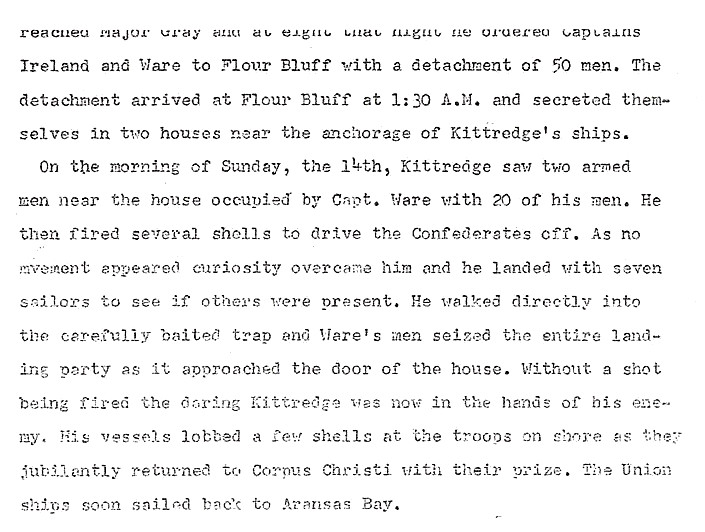 (Ref. 3240) 89 There was not much time to rest on
his laurels, however. After James was part of the operations at
Flour Bluff in mid-September, he was active at the conflict at Sabine
Pass on Sept. 24th
-25th. In a message
from Lt. Col. W. H. Griffin, the colonel wrote:
“Assistant Adjutant General “I have the honor to bring to the notice and consideration of the Commanding General in order to properly defend Sabine Pass I have found and still find it necessary to keep troops, scouts, and pickets on the Louisiana side of the channel . . . I have already instructed Captain James A. Ware, commanding the cavalry squadrons, to keep scouts on the Louisiana shore and to capture all parties of Federal depredators upon or landing upon the coast. I have the honor to be very respectfully, W. H. Griffin, Lieutenant
Colonel commanding Sabine Pass” (Ref. 3234)
Many years later, in his obituary,
it was verified that James “performed
much active service upon the coast of Texas and during his service
captured the celebrated Captain Kittredge while making a foray upon San
Padre Island. His company was afterwards placed in Yager’s
regiment of cavalry, where he served with great distinction,
participating in all the battles in Louisiana.” (Ref.
Obituary)
James and his company of Ware’s Tigers stayed active all the month of October and half of November scouting for General Bee. “General Bee’s report of November 1, 1862, showed that there were then stationed at Corpus Christi and vicinity the following military units: Major Hobby, four companies of infantry, 303 man, at Corpus Christi; Captain H. Willke, one company light battery; Captain B. F. Neal, one company heavy artillery, 91 men, unattached; Captain James A. Ware, one company Texas Mounted Rifles, unattached; Captain John Ireland, one company of infantry, 120 men unattached. The Commander of the Military District considered that all unattached and independent units in the Corpus Christi-Indianola sector, as well as some others, should be formed into a regiment for better coordination.” (Ref. 3296) It was a grueling tour of service, but “although hampered by lack of funds, supplies, ammunition, and proper equipment, and constantly plagued by inhospitable terrain and bad weather, the regiment fulfilled its assigned missions.” (Ref. 721) 90 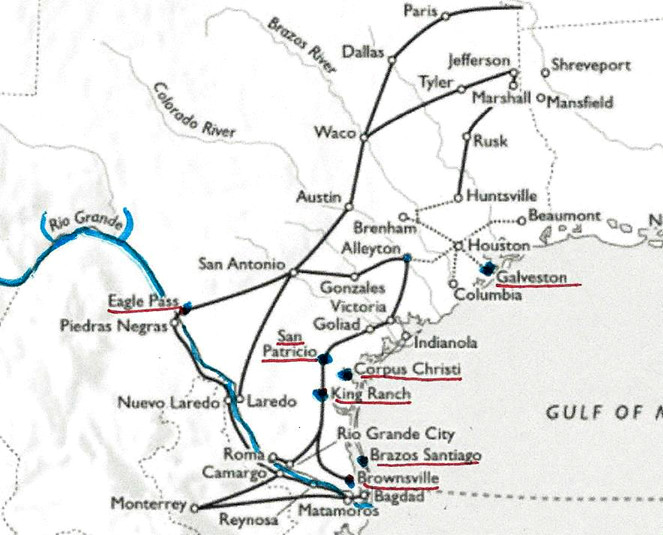 Map of Coastal Region in Texas Finally, in mid-November, James
was granted a furlough to go home. It must have been wonderful
for Jane and the two children (Frances – 3 years old and Somerville 8
months old) to have him home again. Life had not been easy for
them in Corpus Christi, and Jane had been cut off from her family in
Galveston while it was under Yankee occupation.
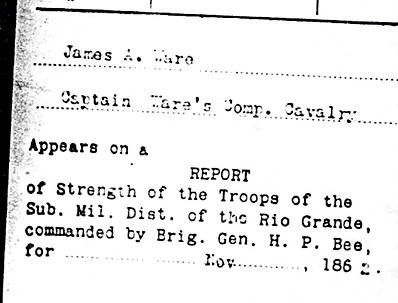 Report of duty for Capt. James Ware 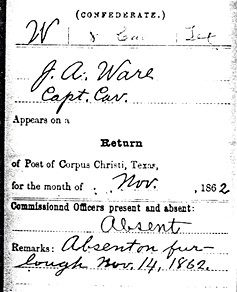 Furlough James had well earned the time
with his family. He was good friends with Matt Nolan, who had
sworn him into service on May 14th, and both men felt a deep obligation
to the people of Corpus
91 Christi. Matt had met his
wife there earlier in 1862 and “. .
. while there he witnessed the condition of affairs between Nueces and
the Rio Grande, saw the whole scope of country without defense and the
property of Confederate citizens at the mercy of their enemies. . . .
It was very natural for Nolan to desire to act in defense of his
relatives and friends. At that time, Captain James A. Ware of Colonel [Augustus] Buchel’s regiment
was commanding the small Confederate force on the Nueces. Ware had been impelled by considerations
similar to those actuating Nolan. His wife had been a resident of
Corpus Christi. In these two officers – in fact, in many others
which were coming to the front – the people felt that they had
something tangible and firm on which they could depend in the hour of
adversity and trial. Nolan and Ware had obtained leaves of absence from their
respective commanders to remain in that section.” (Ref.
1006) Both men spent many long, arduous hours in the
saddle while scouting the area for enemies. As one citizen of the
region wrote later, “It is said that
the Federal soldiers were afraid to venture that far out into the
country, for fear that the Confederates might get them. Captain
James Ware, with his Confederate soldiers, was camped at the Puerta
Ranch on the Agua Dulce Creek near Banquete.” (Ref.
Biography of Eli T. Merriman) It had probably been a long
time since James had seen his family.
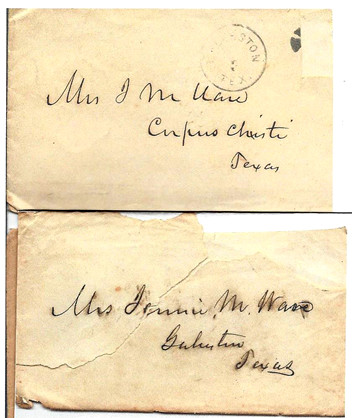 Envelopes from letters addressed to Jane Ware during the Civil War, showing her living in Galveston and Corpus Christi property of James and Judy Ware 92
|
|
This site maintained by John Reagan |